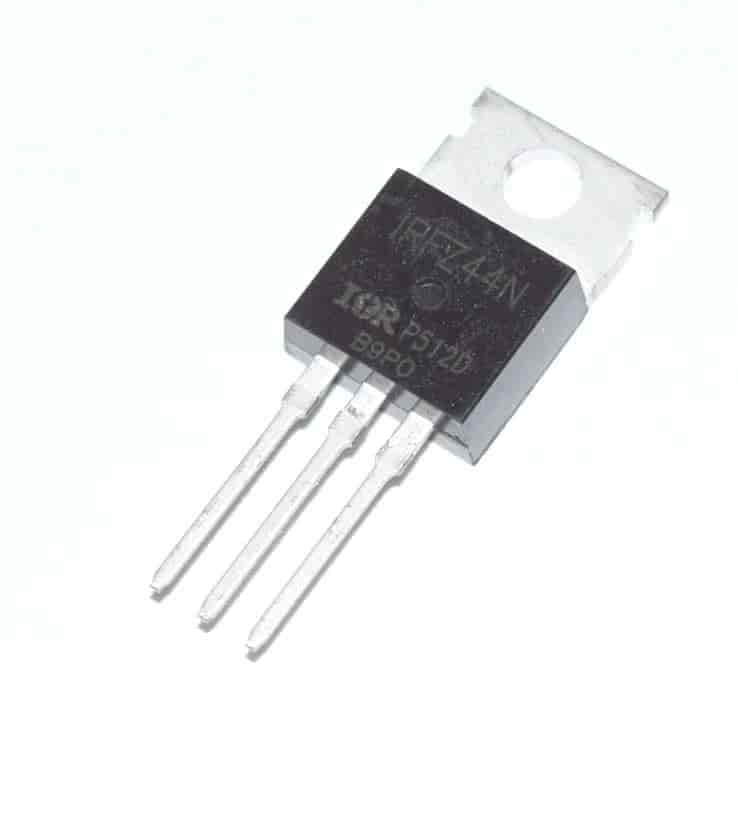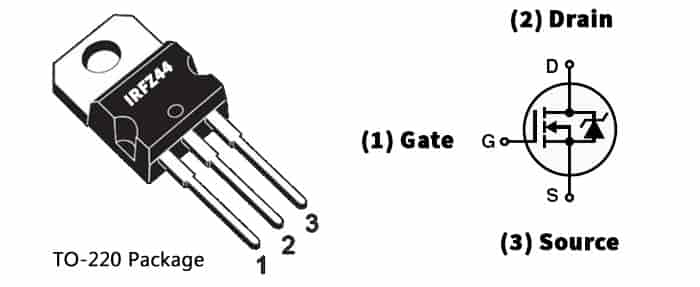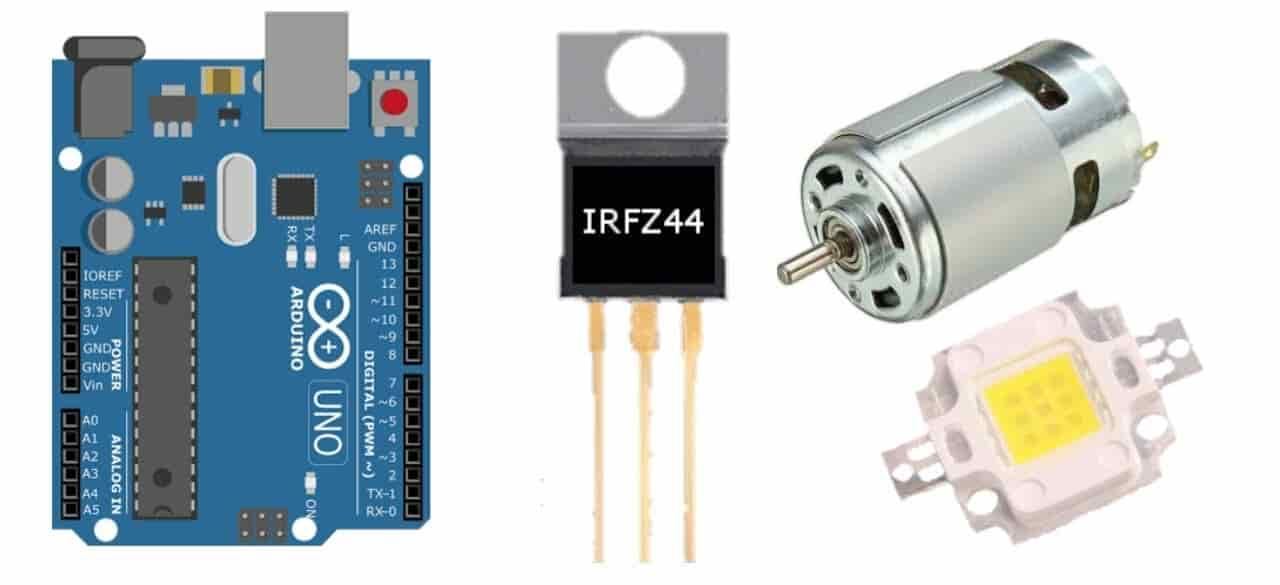IRFZ44N MOSFET
The IRFZ44N is a popular N-channel MOSFET, designed to handle high amounts of current and voltage with ease. In this article, we'll explain the main electrical features of the IRFZ44N, how it connects to circuits, and some common ways it is used in various applications.Catalog

Figure 1: IRFZ44N MOSFET (Metal Oxide Semiconductor Field Effect Transistor)
What Is the IRFZ44N?
The IRFZ44N is a durable N-channel MOSFET (Metal Oxide Semiconductor Field Effect Transistor) made by Infineon Technologies. It's designed to handle high currents, supporting up to 49A, and can work with voltages as high as 55V. This makes it useful for controlling large electrical loads in different electronic circuits. With a low resistance when it's on (Rds(on)) of just 17.5 milliohms and a gate voltage requirement between 2V to 4V, the IRFZ44N is often used in devices like power supplies, motor controllers, and audio amplifiers.
Unlike regular transistors that rely on current to function, the IRFZ44N is controlled by applying a voltage to its gate. This design makes it energy-efficient, as it produces less heat during operation.
IRFZ44N Pinout

Figure 2: IRFZ44N Pinout
The IRFZ44N is an N-channel MOSFET often used in electronics for turning things on and off or for increasing signals. It has three main pins, each playing a specific part in how it works within a circuit.
The Gate (G) pin controls when the MOSFET turns on or off. When a voltage is applied to the gate, it allows electricity to flow between the drain and source pins. The gate acts like a switch: when enough voltage is applied, it "opens" the path for current to move. One thing to note is that MOSFETs are controlled by voltage, not by the amount of current flowing through them. This means they can be turned on with very little power, which makes them more efficient in many circuits.
The Drain (D) pin is where the current enters the MOSFET. When the MOSFET is turned on by applying voltage to the gate, current flows through the drain and heads toward the source. In an N-channel MOSFET like the IRFZ44N, the drain usually connects to the positive side of the power supply.
The Source (S) pin is where the current leaves the MOSFET. In an N-channel MOSFET, the source is typically connected to the ground or the negative side of the power supply. When the MOSFET is "on," electricity flows from the drain, through the MOSFET, and out through the source.
Pin Configuration
|
Pin
No. |
Pin
Name |
Description |
|
1 |
Gate |
Controls MOSFET switching |
|
2 |
Drain |
Current enters here |
|
3 |
Source |
Current exits here |
Key Electrical Characteristics of the IRFZ44N
The IRFZ44N is a widely used N-channel MOSFET, commonly found in different electronics projects and power systems. To use it correctly and safely, it’s helpful to understand its basic electrical properties. In this section, we will explain some of the main characteristics of the IRFZ44N, such as voltage and current limits, and other details that affect how it works in a circuit. This will help you avoid damaging the MOSFET and ensure it functions well in your projects.
Drain-Source Voltage (Vds)
The Drain-Source Voltage (Vds) of the IRFZ44N is rated at 55 volts. This is the maximum voltage that can be applied between the drain and source terminals. Going over this limit can damage the MOSFET permanently.
Drain Current (Id)
The Drain Current (Id) indicates the maximum current that can flow through the MOSFET, which is 49 amps. However, this current rating depends on proper cooling. If the MOSFET gets too hot, it may not be able to handle this much current.
Gate-Source Voltage (Vgs)
The Gate-Source Voltage (Vgs) should not exceed ±20 volts. If this voltage goes beyond this range, the MOSFET can be permanently damaged.
Gate Threshold Voltage (Vgs(th))
The Gate Threshold Voltage (Vgs(th)) is the minimum voltage needed to turn the MOSFET on. For the IRFZ44N, this is between 2 and 4 volts. If the voltage applied to the gate is lower than this, the MOSFET will remain off.
On-Resistance (Rds(on))
The On-Resistance (Rds(on)) is the resistance between the drain and source when the MOSFET is fully turned on. For the IRFZ44N, this value is 17 milliohms. Lower resistance allows more efficient current flow, with less energy lost as heat.
Total Gate Charge (Qg)
The Total Gate Charge (Qg) is the amount of charge needed to switch the MOSFET on or off. For the IRFZ44N, it is 44 nanocoulombs (nC). A higher gate charge means the MOSFET may take longer to switch between on and off.
Common Uses of the IRFZ44N MOSFET

Figure 3: Common Uses of IRFZ44N
The IRFZ44N is a type of N-channel MOSFET known for its ability to handle high levels of current and voltage. It can switch on and off quickly and is designed to control power loss effectively, making it useful in many electronic systems. Below, we'll look at where this MOSFET is commonly used and how it works in different situations.
Power Supplies
The IRFZ44N is often used in power supply systems to help control the flow of electricity to different parts of a circuit. You'll frequently find it in devices like DC-DC converters and voltage regulators, where it handles large amounts of current and voltage. Its fast switching helps reduce the heat generated during operation, which makes the system more dependable. This quick switching also helps reduce wasted energy, making the power supply more efficient. This kind of efficiency is useful in things like laptop chargers or renewable energy systems, where saving power matters a lot.
Motor Control
This MOSFET is also used in motor control systems, where it helps adjust the speed or direction of motors. In applications like electric cars, industrial machines, or robots, motors need a lot of current to work, and the IRFZ44N can handle that without getting too hot. Its ability to switch quickly allows for smooth control over the motor's operation, whether you need to change speeds or reverse direction. This makes it a good choice for machines where precise movement is needed, such as in robots or conveyor belts in factories.
Audio Amplifiers
In audio systems, the IRFZ44N is often used in Class D amplifiers, which are known for being efficient and producing high-quality sound. This MOSFET handles the high current needed to power speakers, while keeping power losses low. This helps improve the clarity of sound, especially at higher volumes. Because it switches quickly, it also helps to reduce distortion, giving a cleaner, crisper sound. It's a great fit for audio systems where good sound and efficient power use are both needed, like in home theater setups or car audio systems.
Lighting Control
The IRFZ44N is also used in LED lighting systems, such as those in cars, industrial settings, or architectural lighting. It controls the flow of current to the LEDs, making it possible to adjust brightness and color. LEDs often need a lot of current to produce light, and this MOSFET can handle that while keeping energy waste low. Its fast switching ability also helps ensure smooth dimming and precise color control, making it ideal for creating different lighting effects, whether it’s for decorative purposes or functional lighting in vehicles.
Switching Power Supplies
Switching power supplies are used in many household electronics like computers, televisions, and game consoles. These power supplies convert electricity efficiently by rapidly turning current on and off. The IRFZ44N is often used in these devices to manage large currents without wasting much energy. Its fast switching allows the design of smaller and more efficient power supplies, which is especially helpful in portable electronics where space is limited. Also, since it generates less heat, cooling becomes easier, which helps these systems last longer.
Conclusion
The IRFZ44N is a reliable and widely-used MOSFET because it can handle large electrical loads efficiently. It switches on and off quickly and works well in systems that need to save energy and reduce heat, like power converters, motor controls, audio amplifiers, and LED lighting. By understanding its main features and how to use it properly, you can make the most of its performance in a wide range of electronics projects.
Frequently Asked Questions [FAQ]
1. What is the input voltage of IRFZ44?
The input voltage for the IRFZ44N, or gate voltage, typically ranges between 2V to 4V to start turning it on. To fully turn it on, a gate voltage of around 10V is commonly used in many circuits for optimal performance. The MOSFET can handle up to 55V between its drain and source (Vds).
2. What is the replacement for IRFZ44N?
A common option to replace the IRFZ44N is the IRLZ44N, which can turn on with a lower voltage, making it better for use with devices like microcontrollers. Other suitable replacements are the IRF3205 and STP55NF06, which have similar performance. When choosing a replacement, make sure it can handle the same voltage, current, and resistance that your project needs.
3. Which is better MOSFET IRF3205 or IRFZ44N?
The better choice between the IRF3205 and IRFZ44N depends on what you need them for. The IRF3205 can handle more current, up to 110A, making it a good fit for projects that require a lot of power, like motor control or power supplies. It also produces less heat because of its lower on-resistance. The IRFZ44N, on the other hand, can manage up to 49A, which is still a good amount for smaller projects. It also needs less voltage to turn on, which can make it easier to use in lower-power circuits or simpler setups. If you’re working with heavy loads, go with the IRF3205. If you’re doing lighter, hobby-level projects, the IRFZ44N might be more convenient.
4. What is the alternative to the IRFZ44N MOSFET?
Other MOSFETs that can be used instead of the IRFZ44N include the IRLZ44N, FQP30N06, and STP55NF06. These alternatives offer similar features and can work in similar circuits.
5. What is the voltage drop of IRFZ44N?
When the IRFZ44N is fully on, the voltage drop across it is very small. This is because its "on" resistance (Rds(on)) is as low as 17.5 milliohms, which means the voltage drop depends on the amount of current flowing through it but is generally very low when it’s turned on completely.